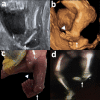Prenatal diagnosis of tibial hemimelia type I and omphalocele, a rare entity and postnatal correlation
- PMID: 33614110
- PMCID: PMC7869132
- DOI: 10.1259/bjrcr.20200002
Prenatal diagnosis of tibial hemimelia type I and omphalocele, a rare entity and postnatal correlation
Abstract
Hemimelia is a rare anomaly affecting the distal long bones of extremities, with an occurrence of 1-20 cases per million of live births depending on the affected bone. Hemimelia can be an isolated defect or be part of complex syndromes that affect extra skeletal structures. Prenatal detection by routine ultrasound imaging is difficult and yields low detection rates. The prenatal diagnosis of hemimelia should prompt a complete and detailed study of the fetal anatomy, since it can be associated with defects in other structures and systems, as the reported in this case. The prognosis depends upon the associated anomalies.
© 2021 The Authors. Published by the British Institute of Radiology.
Figures




Similar articles
-
Tibial hemimelia in one of the identical twins.J Pediatr Orthop. 2010 Oct-Nov;30(7):742-5. doi: 10.1097/BPO.0b013e3181edba12. J Pediatr Orthop. 2010. PMID: 20864864
-
Usual Presentation Has Odds: Unilateral Tibial Hemimelia in One of Dizygotic Twins.Cureus. 2021 Jan 21;13(1):e12834. doi: 10.7759/cureus.12834. Cureus. 2021. PMID: 33633877 Free PMC article.
-
[Prevalence of selected congenital anomalies in the Czech Republic: renal and cardiac anomalies and congenital chromosomal aberrations].Epidemiol Mikrobiol Imunol. 2013 Sep;62(3):112-28. Epidemiol Mikrobiol Imunol. 2013. PMID: 24116699 Czech.
-
Systematic radiographic evaluation of tibial hemimelia with orthopedic implications.Pediatr Radiol. 2017 Apr;47(4):473-483. doi: 10.1007/s00247-016-3730-8. Epub 2017 Jan 3. Pediatr Radiol. 2017. PMID: 28050636 Review.
-
Evaluation of prenatally diagnosed structural congenital anomalies.J Obstet Gynaecol Can. 2009 Sep;31(9):875-881. doi: 10.1016/S1701-2163(16)34307-9. J Obstet Gynaecol Can. 2009. PMID: 19941713 Review. English, French.
References
-
- Jones T. Tibial Deficiency. OrthoBullets. 2016. Available from: https://www.orthobullets.com/pediatrics/4058/tibial-deficiency.
Publication types
LinkOut - more resources
Full Text Sources
Other Literature Sources

